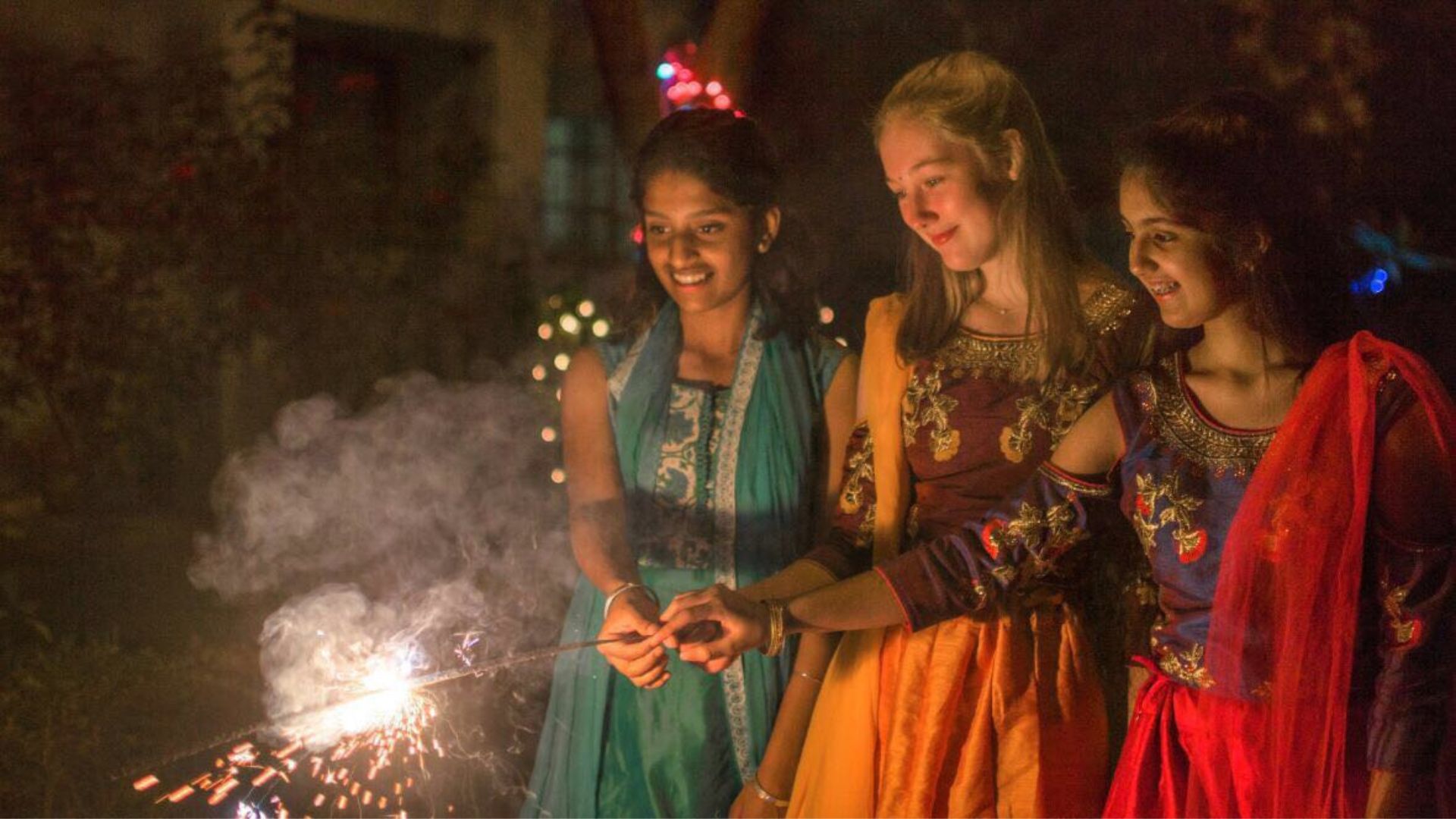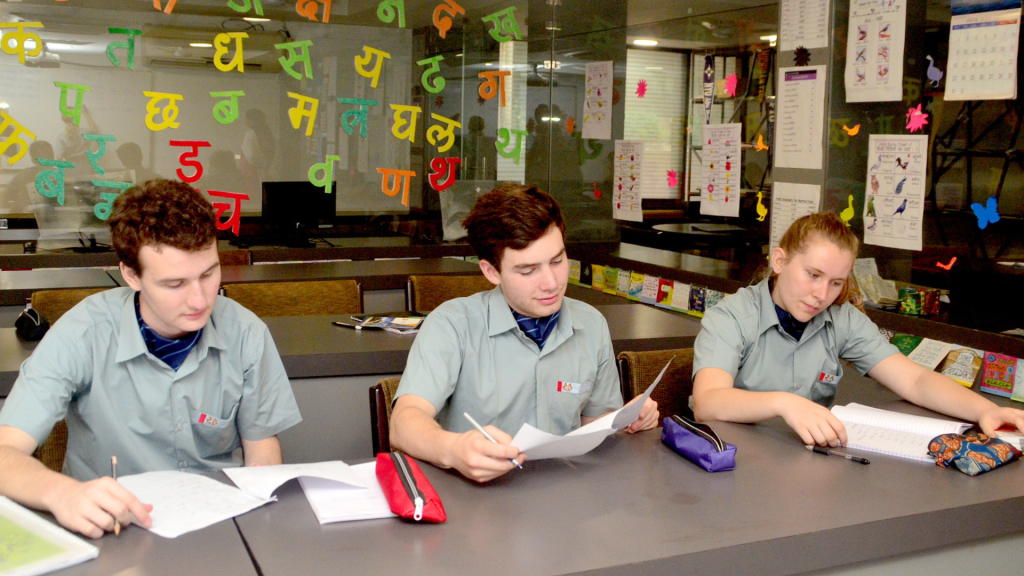American high school students learn Hindi and experience Indian culture through an intensive exchange program.
August 2022

Alice McGuinness, an NSLI-Y participant from the United States who was in India for the language learning program, celebrates Diwali with her host family in Indore. Courtesy NSLI-Y
The best way to learn a language is to immerse yourself in it completely, or as completely as possible. For American high school students interested in learning Hindi, the National Security Language Initiative for Youth (NSLI-Y) provides opportunities to do just that.
NSLI-Y was launched in 2006 to promote critical language learning among American youth. The U.S. Department of State, in cooperation with American Councils for International Education and other program partners, awards and administers merit-based scholarships to high school students to learn eight languages: Arabic, Chinese (Mandarin), Hindi, Indonesian, Korean, Persian (Tajiki), Russian and Turkish.
Students can engage in intensive language immersion in various locations around the world, including India, where the eight NSLI-Y languages are spoken. American students can choose from programs that span the academic year or last six to eight weeks during the summer, both of which offer unique experiences.
This year, seven U.S. high-school students completed the 2022 NSLI-Y summer program in New Delhi, wherein they received 120 hours of Hindi language instruction. Their time in India included celebration of Raksha Bandhan and the Indian Independence Day. At the program’s closing, students demonstrated their Hindi proficiency while performing Indian songs and dances for teachers and host families.
“What makes the NSLI-Y programs, including the Hindi program, unique is the approach toward language learning. Both summer and academic year participants’ language learning is intensive, immersive and experiential, through a structured curriculum and planned cultural excursions, where participants practice their language skills,” says Roshan Sajan, deputy hosting operations at AFS India. AFS India is part of AFS Intercultural Programs, a nonprofit organization that provides intercultural learning opportunities in more than 50 countries, and is a NSLI-Y partner organization in India.
These excursions include visits to Varanasi for the academic year program participants, as part of a learning project for their language class.
“Before their trip, students pick a topic of interest related to their host country. They then interview locals and conduct fieldwork during their trip. Topics range from kathak to environmental activism on the Ganges River, from ghats and temples to Varanasi street food,” says Kristell LeGoff, NSLI-Y specialist at AFS-USA. The participants “present in Hindi to their class and write a culminating essay,” she adds.

NSLI-Y Hindi program participants learn all four language skills—reading, writing, speaking and listening—through carefully designed activities. (Photograph courtesy NSLI-Y)
In 2018, yearlong students in India also took a four-month-long yoga course, taught by a certified guru, as well as Indian dance, music and art classes. For both yearlong and summer attendees, community service is integral.
“Over the past few years, participants volunteered to teach English to underprivileged children, to work at a vision camp that provides free eye examinations and glasses to people of any age or economic status, and to build washroom facilities for female students,” says LeGoff. “They have also planted trees, talked to and assisted with the care of senior citizens, and spent time at the Indore Cancer Foundation, among many other community service activities. Participants have valued the opportunity to give back to their host community while using their Hindi skills to understand different issues affecting Indian society.”
Language acquisition and cultural immersion continue at “home,” too, while participants are in India.
“Participants also develop their language skills with their host families and are exposed to the Indian family system, values and traditions,” says Sajan. Summer participants live with host families the whole time, while academic year program students spend the first half of the year with host families, then transition to boarding at their host schools during the week. The boarding experience enhances peer-to-peer learning, says Sajan, while also building a sense of family at school.
“Participants often share that they feel very welcomed and happy when the junior students address them as bhaiya and didi, which is the Indian way of giving respect to elder students,” he says.
The NSLI-Y Hindi program hosts American participants in Indore and Pune each year. Approximately 30 students attend the summer program and 5 attend the academic year program at a time. Admission officers assess applications for motivation for language learning, sense of character and demonstrated cultural awareness to make sure the applicants are mature enough and ready for an international experience.
Applicants also have to explain how their language study is linked to their future academic or professional goals—a consideration the NSLI-Y administrators hope will influence participants’ Indian peers.
“The program is a great example for Indian youth on how pursuing language learning through exchange could also be part of their career and personal development plans. We hope that NSLI-Y inspires Indian youth to consider language programs and opportunities that encourage cross-cultural understanding,” says Sajan.
NSLI-Y alumni continue to pursue their Hindi studies and usage after finishing the program. “One example is that of a summer program alumnus who recently returned to participate in a Model United Nations event at his host school in Indore. Also, we had a NSLI-Y alumna who returned to India to work as an intern at her host school and, then, became an educator for children with vision and hearing impairments,” says Sajan. LeGoff adds, “Several alumni have applied to colleges that have a Hindi language program, as they are now devoted to learning even more of the language and the culture.”
Another alumna got creative and found a job at an Indian restaurant, where she could continue to practice the language, says LeGoff.
Sajan emphasizes that participants “cherish the lifelong bonds and memories they create on their exchange,” a testament confirmed by Jackie Foster, a summer student who wrote a reflection at the end of his time in India. “Throughout my exchange, I enjoyed learning Hindi and I learned a lot of life lessons, which will help me for the rest of my life. My host family was amazing, and I don’t even consider them my host family anymore, they are now my family,” Foster writes. He adds, “Outside of my family and school, this experience allowed me to become a better global citizen. I learned the true identity of India and I’m glad I was able to show them what it truly means to be an American. I am forever grateful.”
Carrie Loewenthal Massey is a New York City-based freelance writer.
This article was originally published in January 2019
COMMENTS